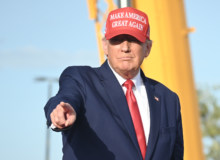Republished with permission from Gary Gindler:
Only now has Trump’s economic policy become clear: Trump squeezes out companies from abroad and forces them to relocate to the United States.
On Friday, March 23, 2018, new tariffs for steel and aluminum, signed by President Trump on March 8, came into effect. Two weeks have passed, and the promised apocalypse of the world tariff war did not happen. The reaction of America’s leading trading partners somehow turned out to be muted and unconvincing and, in many cases, just nothing, as if nothing had happened.
Why? After all, according to the TV hysterics, Trump went against the fundamental idea of the world-famous Nobel laureate in economics, Milton Friedman. Friedman once argued that tariff wars always play a negative role for consumers of final products. Since then, we are all frightened by the idea of tariff retaliation, as if all other countries will also raise tariffs, leaving American citizens to take the brunt, or so the theory says.
In practice, most of the world has been imposing tariffs on American products for decades, and no administration before Trump has even tried to protest earnestly. Our country is surrounded by high tariff walls. And tough tariff war against American industry has been going on since the time of the emergence of the European Union.
For example, China has set tariffs for motorcycles in the amount of 30% to 45%, depending on the cubic size of the engine. (All data on tariff rates for all countries are from the World Trade Organization database.) Chinese car tariffs are 25%. Therefore, on the roads of China, you will see neither Harley-Davidson motorcycles nor Ford trucks. In total, China has set about 300 different tariffs for American cars, buses, trucks, and spare parts for them.
For comparison, China has established a purely symbolic tariff for airplanes – from 1% to 4%, depending on the weight of the aircraft, and spare parts for aircraft have a zero tariff. By the way, steel in China is also subject to a tariff – from 0% for scrap metal to 10% for rolled steel products. And the tariff for aluminum is up to 25%.
The European Union has set tariffs for cars at 10%, for trucks at 15.8%. In Europe, everything that moves – bicycles, motorcycles, tractors, and buses – is taxed. In total, Europe has set more than 250 tariffs for land transport, more than 250 tariffs for various vegetables (up to 14.4%), and more than 200 tariffs for multiple types of meat (up to 15.4%).
Even all these figures (thousands of tariffs for American goods) do not produce a complete picture of the trade war being waged against America. There are other levers of economic warfare in the arsenals of many countries.
For example, many jurisdictions charge imported goods not only with a tariff but also with an additional value-added tax (VAT). Also, other countries require (as a rule, in addition to tariffs) separate payments for “quality inspection of goods.” In China, for example, such inspections can be carried out for weeks, and an exporter company is forced to pay substantial demurrage fees.
Finally, China has successfully adopted the old Soviet practice. To make an entry into the Chinese market, American companies are forced to establish a joint venture with a Chinese company, with mandatory disclosure and transfer of all technological know-how to China. Software companies pay this price of entering China’s marketplace in the form of transferring to Chinese authorities full source code of all programs and all other intellectual property.
What did China do in retaliation for imposing tariffs on steel by Trump? China, instead of retaliatory increases in tariffs for American goods (expected by the economists of the Washington swamp), decided to reduce its 25% tariff on cars and finally allow American companies to enter the Chinese automobile market on approximately the same terms as Japanese and German car manufacturers.
Why did China and other countries act contrary to the theory of Friedman? Because Friedman’s arguments, unfortunately, are correct only when all other variables in economic equations remain unchanged.
Trump had changed the overall conditions of the economic game.
On the one hand, Trump raises taxes for companies outside America (tariffs), and on the other hand, he reduces domestic taxes for companies in America. Let me remind you that thanks to Trump, now corporate income tax in America has been reduced from 35% to 21%. Also, the lion’s share of bureaucratic barriers to business development, set by Obama, are canceled by Trump.
Only now has Trump’s economic policy become perfectly clear: Trump squeezes out companies from abroad and forces them to relocate to the United States.
The lack of tariff retaliation of the U.S. trade partners proves once again that the capitalist economy is a nonlinear system in which, as is known, the sequence of events is significant. Trump had lowered domestic corporate taxes, and after only three months, he increased external taxes. Imagine what would have happened if the sequence of these events had been in reverse. First, Trump would have raised external taxes (tariffs), and three months later, he would have lowered the internal ones. More precisely, he would try to reduce them, because in the nonlinear system, A + B is not equal to B + A, and it is unlikely that the political situation after a unilateral increase in tariffs by America would be favorable.
From a political point of view, Trump’s tariff solution is a cold calculation.
Trump realized that the political price of inaction during the World Trade War is too high. And all other countries wisely decided to remain silent. They realized that Uncle Sam has woken up.





















Join the conversation!
We have no tolerance for comments containing violence, racism, vulgarity, profanity, all caps, or discourteous behavior. Thank you for partnering with us to maintain a courteous and useful public environment where we can engage in reasonable discourse.